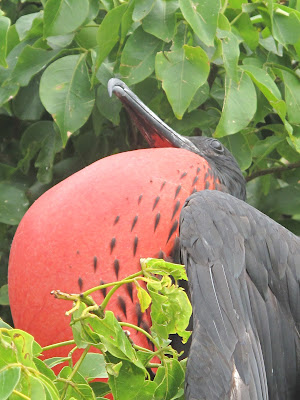Isla
Isabel is known as the “Galapagos of Mexico” because of its large numbers of
nesting birds and iguanas. In 1981 Isla
Isabel was given national park status and in 2003 was made a World Heritage
site. On January 1st we
departed from San Blas and motored 40 miles northwest to Isla Isabel where we
arrived shortly before sunset.
The
next morning Mark went over to a nearby boat that was having trouble raising
its anchor to offer assistance. They
said that they felt they could manage their anchor but could we go out and help
the s/v The Rose that was trying to free a whale from a net? We fired up the engines, woke the kids and
headed out to the s/v The Rose that was about ¾ mile off the island. John from The Rose had been in the water for
at least an hour and was tiring quickly.
They were looking for a strong swimmer and Neil volunteered. Two other boats also came out from the
anchorage to assist. The rescue
operation had started the day before but had to be abandoned as daylight slipped
away. Fortunately the whale was found
again the next morning and was still alive!
 |
| Mark, Neil and the whale |
We
motored out to near where a marine specialist was directing operations from a
dingy and John was in the water with the whale. Mark and Neil paddled our dingy over while I
stood off on Three Hour Tour and Lisa was our official photographer.
Neil
went into the water and an exhausted John was pulled into the dingy but before
Neil could reach the whale it began to swim away and he couldn’t catch it. A call came over the radio from one of the
other boats that the whale appeared to be free which brought cheers from
everyone. Mark and Neil came back to the
boat with a dingy full of fishing net and we headed back to the anchorage
feeling pretty pleased even though our role had been somewhere between miniscule
and non-existent.
On
the way back to the anchorage a small pod of 3 or 4 whales came right up behind
the boat. During the videoing of their
approach I sat down, not sure that they wouldn’t hit the boat. You can tell from our dialogue on the video
that we were somewhat concerned. We know
of a boat that was hit by a whale at anchor in La Cruz so it does happen. Anyway, at the last minute they went around
us.
Later
that morning I took this video of a whale that was repeatedly slapping its tail
on the water. When he started slapping I
didn’t get the camera because I was sure he would stop right away but as he
continued I decided to try to get a video.
I estimate the whale slapped its tale in this fashion between 30 and 40
times and I was able to catch the tail end (ha ha) of it.
In
the afternoon we went to the island to see the boobies, frigate birds and
iguanas. Even when they are nesting, the
birds are not particularly afraid of people because there are few natural
predators. The boobies usually have only one egg but this proud momma had two.
The frigate birds nest in the small trees on the island
and every tree had numerous nests. The boobies nest on the ground. The brown boobies build a nest with straw but the blue-footed boobies just make a slight depression in the dirt.
 |
| Proud brown boobie parents with their chick |
 | ||
| Pair of blue-footed boobies with their egg |
 | |||
| Frigate bird momma with her chick. So cute! |
 |
| Male frigate bird |
Isla
Isabel was formed by volcanic activity as evidenced by the geology (according
to Neil). The caldera of this extinct
volcano is now a lake in the centre of the island.
 |
| Lago Cráter |
The
kids opted to stay another day so the next day was spent collecting sea glass,
snorkelling and walking the trails of the island. We left Isla Isabel at 4:30 pm for an
overnight trip back to Chacala. The
Quadrantid meteor shower was to be that night.
It is a brief shower and we didn’t see any meteors until around 4
am. It was also very near full moon
which may have obscured some of the fainter meteors.
We
made a brief stop at Chacala and carried on to Jaltemba were we had lunch at
Latitude 21, a restaurant owned by an American expat.
 |
| Lunch in Jaltemba |
From
there we headed back to La Cruz from where the kids would fly home.
 |
| Dinner! |













